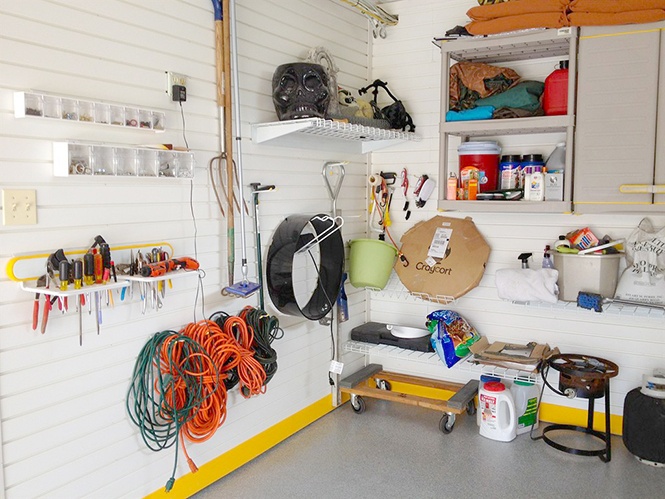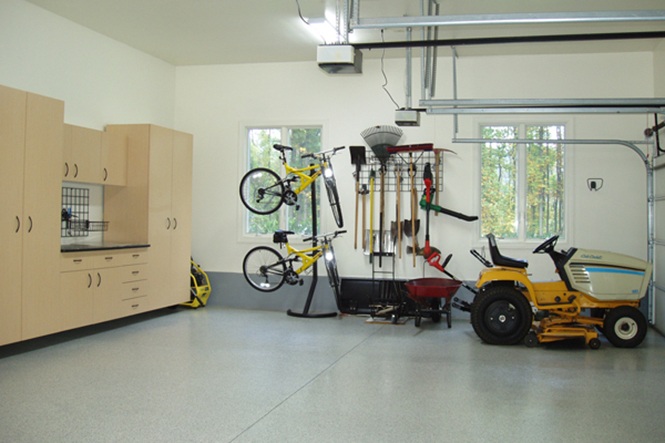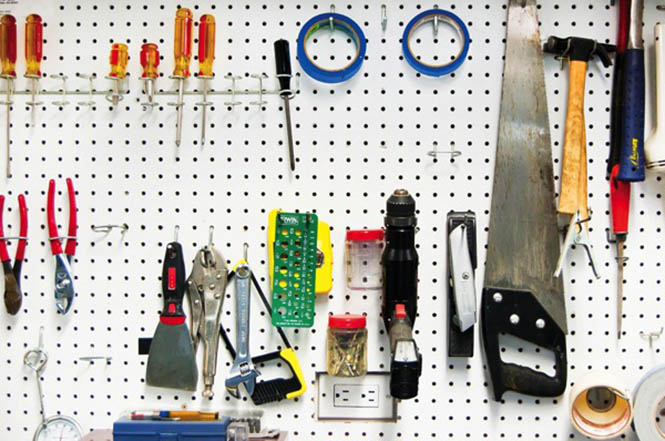By Angie's List

Photo courtesy of Mathes
Plan it first
If you’re ready to tackle your mountain of junk in the garage, follow these step-by-step suggestions for clearing the clutter:
1. Inventory - Assess what stuff you have in your garage now and decide whether some of it should be gotten rid of altogether or stored in a better place. Decide what really needs to stay in the garage.
2. Categorize - Decide what stuff should go together. Automotive products should stay together, children’s toys should be grouped together, and lawn and yard work implements should be grouped together, etc.
3. Assess available space for biggest items - There may be only one corner where large items could go, or only one wall where shelving could go. If you have one big object like a freezer and only one place where it fits in the garage, start there and work around the space from there.
4. Envision – For the remaining space, do you want shelving, kitchen-style cabinets, a work bench? How can you use the wall space and even ceiling space for better storage?
5. Remove everything and clean - Haul everything out of the garage and stack it up where it will be safe and dry in case this process takes several days. Decide what you want to throw away and/or move elsewhere and eliminate those from the mix. Sweep, clean and paint. Put the cars back in so you have a feel for the remaining space you can use.
6. Build stuff - Put in storage shelving, a work bench or whatever you have decided will meet your needs. Make sure you are building something that works well with all the stuff you have sitting out in the driveway right now.
7. Back in place - Put everything back.
Cleaning the floor

Photo courtesy of Stronghold Floors
Cleaning the floor of your garage can be a difficult task because of oil and grease buildup from cars, lawn mowers or accidental spills. Using the right cleaners and knowing the steps to getting a concrete floor clean will allow you to have your garage floor looking new.
Step 1: Sweeping
Using a large broom, start by sweeping up and dirt and dust that has built up on your garage floor. Prior to starting, you may want to remove your vehicles from the garage, as sweeping can produce a higher than normal amount of airborne dust. You may also want to use a dust mask to prevent irritants or dust from entering your airway.
Step 2: Removing oil and grease stains
Using a specialty oil or grease-absorbent (which can be purchased at most automotive retail stores), thoroughly coat any dark stains from oil or grease that are on the floor. It can be less expensive, yet just as effective, to use kitty litter.
Leave a generous amount of either absorbent on the stains overnight, then sweep it away in the morning.
Step 3: Chemical Cleaners
Purchase a cleaner that is specifically labeled for heavy-duty floor cleaning jobs. Use it according to the instructions on the label, taking care not to use too much.
Step 4: Rinse and Dry
Use a garden hose to rinse the cleaner away, and let your floor air dry.
Using space efficiently

Photo by Blair Bost, Angies List
If you only have a one-car garage, or if you're trying to store a lot of items in your garage along with a car, you'll need some organizing products to help you make the most of tight spaces.
Ceiling Storage
Overhead storage is a great way to instantly gain space in your garage. These storage devices consist of a wire rack that hangs from your garage ceiling. Different sizes are available based on your needs, and most are rated to hold hundreds of pounds.
Wall Storage
Wall storage is great to store tools and loose items that would be lost on the garage floor. You can find kits that are specifically designed for tool storage, or you could even invest in wall-bolted cabinets or wire basket storage.
When organizing, group like items together. If using boxes, be sure to label the outside so you won’t have to dig through all of them while looking for one specific item.
Waste disposal
Many people have cleaning products and outdated paint gathering dust in their garage. Getting rid of these items is more complicated than simply throwing them in the trash or down the drain; the toxicity of chemicals and paint products can do serious environmental damage when not disposed of properly.
To find out how you'll need to properly dispose of your leftover chemicals and paint waste, start by reading the label, as the manufacturer may have included instructions on safe disposal. Before you choose to follow any instructions provided, you should check the rules regarding chemical disposal in your local municipality.
Most municipalities have set guidelines regarding the safe disposal of chemicals, often allowing homeowners to drop their toxic waste off at a local site on specific dates. If you aren't able to find information regarding chemical disposal in your area, contact a landfill to see if they will accept the toxic waste.
This guide originally ran on AngiesList.com.
Read More About Garage Organization and Clopay Smart Technology
- Ideas For National Garage Organization Month
- Smart Home Controls
- Energy House Tour
- Smart Green Home